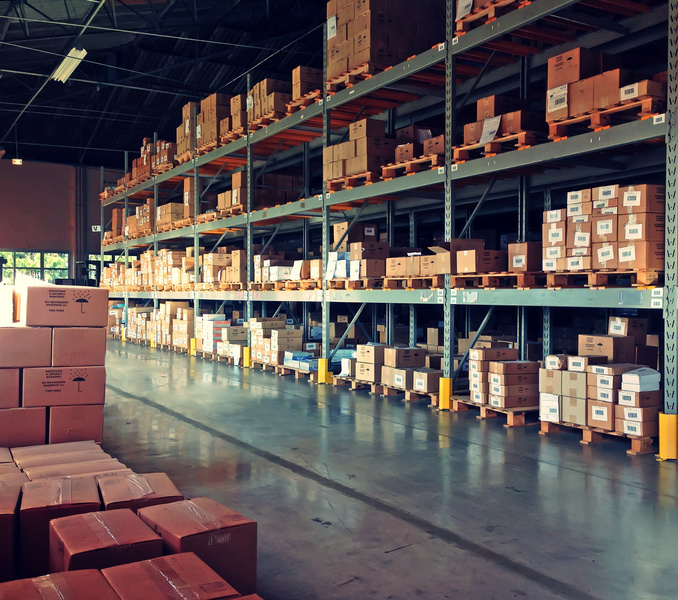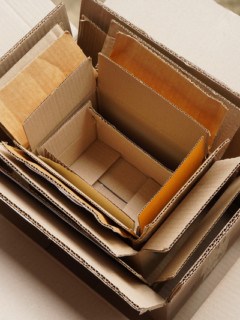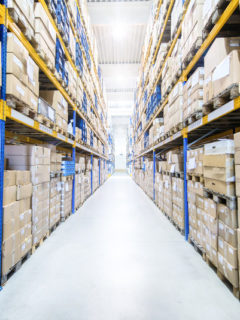Automating the preparation of orders in your warehouse is very important for the logistics of your business. However, if your warehouse is not yet automated, where to start? Which solutions should you evaluate, test and finally choose?
The aim of this post is to help you in your choice and, depending on your business objectives, contribute to the discovery of the available logistics solutions for automation and/or mechanisation.
Define the mechanisation or automation objectives for your warehouse
This step is above all crucial to know why you should mechanise or automate the preparation of your orders.
So think about the objectives you want for your company.
- Increase the order preparation rate?
- Reduce the risk of musculoskeletal injuries for your employees?
- Optimise your budget by improving the performance of your logistics team?
As well as this, you can also ask yourself when you want to achieve these goals and what return on investment (ROI) you are expecting.
Evaluate the order preparation phases that can be optimised
Certainly, based on the goals set in the previous step, identify the phases where mechanisation or automation will have added value. Then, it can be an asset for the logistics of your warehouse, from the point of view of the productivity/profitability of your business and/or the well-being of your employees.
And, of course, it’s not about investing at all costs and all at once in very expensive technologies. In most cases, the change will be made gradually.
Therefore, we put here some examples of how you can make this change step by step:
- In the warehousing phaseyou can reduce injuries to your warehouse staff from moving heavy loads or save time in longer storage processes;
- In the picking phase you can consider shortening overly long picking paths or optimise the flow of your employees;
- In thepacking phase, you can reduce the time spent preparing each package, especially if it is time-consuming because preparation requires real precision or to avoid possible injuries to your employees.
Write a list of possible logistics optimisations and move to the next step.
Prioritise the optimisations to be carried out
As a result, now that you are clear about what your objectives and the different phases should be, determine which optimisations are the most or least urgent/necessary for your warehouse. Therefore, prioritise these actions according to:
- The results you can achieve in terms of productivity;
- The budget to allocate;
- The estimated time to implement these optimisations.
For each optimisation, you can assign each of these criteria a score ranging from 0 (low productivity, high budget, long implementation time) to 5 (higher productivity, low budget, short implementation time).
Once you have your table created, do the sum of the 3 columns, and the optimization with the highest score will be the priority to implement.
Thanks to this system, you now have a realistic and structured project in front of you, based on the ROI you can get from it.
Only after this stage can you ask whether you need to mechanise or automate any packing stations for the preparation of your orders. How to do it? We will address it in the next step.
Find the right mechanisation or automation solutions
First of all, do you have in mind the order preparation stages that you want to mechanise or automate? So now we will know which of the various automation or mechanisation solutions are best suited for your logistics challenges.
What solutions are there to mechanise your warehouse?
“Thanks to mechanisation, you gain productivity and time. Mechanisation is the first step to invest in a more productive and efficient warehouse. ” António Reyes, Director of Logistics at RAJA Spain.
So and despite being a process that requires a great deal of organisation, the mechanisation of a warehouse requires less planning and restructuring of your warehouse than automation . Mainly because automating a process requires deep thinking about the flow, routines of the warehouse team, among others…
Among the simple ways to gain productivity through mechanisation, we often think of investing in machines that:
- Facilitate the transport of loads: pallet trucks for the storage phase, specialised shuttles for picking;
- Fill boxes: paper filling machines for ecological filling, air filling systems for fast filling and foam filling systems for safe filling;
- Secure your goods safely: machines that wrap pallets with film (robot, wrapping machines with manual brake or motorised pre-stretching), machines that seal your boxes with tape (mono-format and multi-format box sealers) and strapping machines (automatic, semi-automatic or manual);
- Theyclose their packaging: e.g. with strapping machines or box sealing machines.
What solutions exist to automate your warehouse?
Certainly, automating a warehouse will generally require more thought and will disrupt many of the current processes in your warehouse.
With a large initial investment, it is possible to automate the entire preparation of your orders. However, it is better to choose to focus on one of the two areas that benefit most from automation:
- The storage and picking area;
- The order preparation area.
In this way, we will present the solutions available to you.
So, we will present the solutions available for automating each of these areas.
How to automate the storage and picking area?
For this first area, solutions which bring the product to the worker are increasingly chosen among the advanced options offered to logistics managers.
Stacker cranes in narrow aisles
In aisles as short as 1.5 m in length, a lift is moved to the required locations. The lift is equipped with a gondola which places it in front of the box of the product to be searched for or the product to be stored.
Thanks to the cable lift in a narrow aisle, we reduce the effort of picking.
The advantages of this technology:
- Great space saving, as the entire picking area can be reorganised in 1.5 m aisles;
- A sharp reduction in the possibility of errors in the order;
- An increase in productivity because it is the lift that will determine the best route for grouping the orders to be prepared.
The points of attention of this technology:
- The lift is not fast. With a maximum speed of approximately 7 km/h, the picking or ado storage speed is constant but limited;
- As with any automated solution, it is necessary to take out maintenance insurance that includes very rapid intervention in the event of an incident;
- In addition, working at height requires the reinforcement of safety rules for those responsible for preparing orders.
The picking carousel
As a result, the picking carousel makes it possible to assemble a huge metal rack containing hundreds of shelf locations. In the case of a vertical picking carousel, all that is required is to scan the product and the rack sends it to the person in charge, who need only associate it with the order he is preparing. It is a particularly suitable system for small products.
Thus, the picking effort is reduced, even if the phase of forwarding the product to the person in charge is not optimised.
The advantages of this technology:
- Better productivity because the employee expects the products to be presented to him/her;
- Reduction of accidents in the warehouse compared to normal picking movements;
- A strong reduction in the risk of possible errors with orders.
The points of attention of this technology:
Therefore, you must make sure that you have maintenance insurance that intervenes quickly and efficiently in the event of a malfunction.
The automatic system
This system mainly uses a tray which is moved through different areas, often corresponding to different types of products. In each area, an employee fills the tray with products. When the tray corresponding to an order is finished, it is sent to the dispatch area. The system is particularly suitable if most of your orders contain more than one product.
With this technology, you optimise the picking and the transport phase to the dispatch area.
The advantages of this technology:
- Above all, with the increase in productivity, those responsible for preparing orders have a restricted area for picking the products;
- A considerable saving in time, since the tray carries out most of the movements automatically;
- A strong reduction in the risk of errors with the order.
The points of attention of this technology:
- In this sense, you must make sure you have maintenance insurance that guarantees a quick solution to incidents, should the need arise.
In addition to the automation of the storage and pickingphases…
In addition to these three automation technologies, there are many automated racking systems that are perfectly suited to pallets and boxes. Connected to a specific Warehouse Management System (WMS), they allow you to automate your racking and monitor the status of your stock at all times.
The Pick-by-Voice system can also contribute to optimising the flow of your employees through a WMS. However, do not forget that for all automated technologies that ship a WMS, you must take into account your needs. In fact, a dynamic WMS currently assigns a product to a location. The rules may vary a little depending on the turnover speed of a product, but in general, the smarter your WMS is, the more it will direct products, to locations, based on optimised paths. So it’s a system that fits well with any warehouse strategy.

According to this, let’s address the solutions available to automate your packing stations.
How to automate the logistics of the packaging area?
Box sealing machines allow the final packaging to be closed automatically. This way you can prepare up to 1200 boxes/hour!
Do you already know which automation or mechanisation technology is most suitable for your warehouse?
Implement these solutions in your warehouse
Now you can implement the various solutions you have chosen. However, pay attention: the mechanisation or automation of your warehouse will change many tools and processes in your daily logistics .
Including technology in your workspace will require a change in your warehouse team. And, like any change management project, it will include:
- Training your employees: in these new tools and in new safety rules;
- Communicate with warehouse staff: approach your team regularly to allow them to share their experience with the new tools.
When implementing new solutions, don’t try to get ROI too quickly. Generally, getting a return on investment on an automation system takes between 3 to 5 years. Some adaptation time is therefore needed to keep your teams motivated and gain productivity in your warehouse.
To sum up: how to automate or mechanise your orders
- Plan your automation or mechanisation project with the right objectives in mind, taking into consideration the productivity of your warehouse and the well-being of your employees;
- Consider mechanisation or automation as a gradual process: target the order picking phases where the technology will bring real added value and then implement it in other less significant segments;
- Choose the technology that really matches your business objectives, assessing the benefits to your warehouse. If you are on a constrained budget, mechanise it. Automation covers more, but is more expensive;
- Lead the implementation of this new equipment as a change management project, preparing employees little by little. The aim: to continue to value their work by explaining to them the benefits of these technologies.
If you need advice, contact our experts on 707 788 008 or contacto@rajapack.pt. They will be happy to help you choose which solutions best suit your business.















